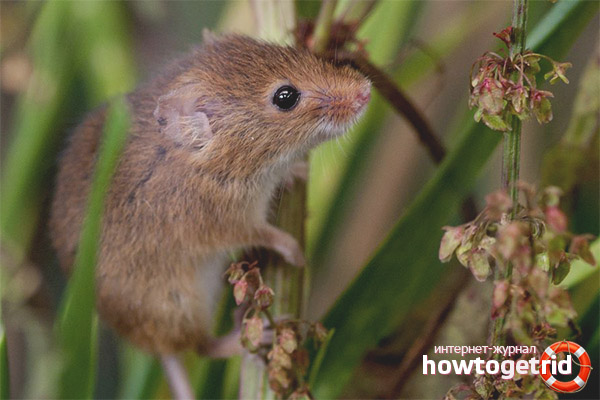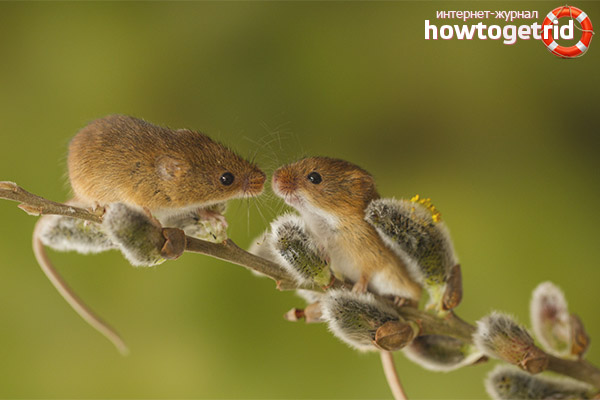The content of the article
Why some women are so afraid of little mice, the scientists decided to find out. And they found out that this fear is laid at the gene level. At a time when men were hunting, and women were raising children in caves, predators suddenly attacked defenseless people. And since then, when even a small animal-rodent suddenly appears at its feet, a woman subconsciously feels danger. And what remains to do? Of course, shout loudly.
The baby mouse can also cause a stir if it is in a living room, despite its very tiny size.
Features mouse-baby
The appearance of this type of mice used to be different in smaller sizes: the length of the body is from 5 to 7 cm, and the tail is usually the same length as the body. Adult individual weighs from 5 to 10 grams.
A small mouse, though small, but it has an advantage over others: a developed musculature of the tail and its remarkable tenacity.And precisely because of this, it can twist around the stems or reeds and without effort to rise up.
This rodent's muzzle is shortened, but dull and pointed at the nose. The nose is somewhat compressed from the sides closer to the front edge. Cheekbones thin and weak. The paws are short, and the feet are elongated - from 12 to 16 mm and narrow, ending in sharp claws. The third finger is always slightly longer than the others.
The animal is covered with very thick and soft coat. The upper part of the body is bright with sandy-ocher tones or dark orange; brownish-olive can also be found. In the back of the back color is more saturated dark. The abdomen is colored white or light gray, and there is a sharp color transition in the area of dark sides. Depending on the season, the baby mouse changes fur colors, however, they are very insignificant. The fur color of the adults is brighter, while the young are dull and much darker.
The incisors of these rodents are long and wide, have round curves behind, and are pointed in front. The upper ones are distinguished by the fact that they are already weaker than the lower ones and have a smooth surface.
The auditory orifices are large, the drum chambers are also large, and have a bulge from the inside.
Habitat
The animals feel most at ease among the thickets of rare bushes, hiding in the weeds, in the wastelands, landfields and fallow lands. Often, the family can be seen near the busy trails. They also live well in high-grass meadows. This type of mice prefers the most humid habitat, because along the banks of rivers, in swamps and marshy meadows, they are also common, especially where the territory is densely overgrown with reeds.
When the cold comes, small mice, fleeing frost, hiding in a dry reed, make a small hole for themselves, or settle closer to people's dwellings - in hay, barns, in the attics of houses or under the floor.
Nutrition

The diet of baby-babies is quite extensive and mainly depends on the time of year. They prefer cereals, legumes, various berries, seeds, young shoots and buds of deciduous trees, shrubs, and reeds. Flower nectar is also a favorite dish of the animal.
Agricultural land attracts them by the fact that a large amount of tasty food is growing in the fields: cereal grains, oats and other cultivated plants planted by people. To reach the grains that are hidden in the spikes, these agile rodents climb up, helping themselves with a long and strong tail. He wraps himself around the stem, helping his mistress keep his balance on the plant that bends away from her weight.
It certainly causes damage to the crop, especially if its numbers are large. But at the same time it can destroy a sufficient number of insects that harm the crop. In the menu of these animals there are various small insects, most often they are beetles, grasshoppers, caterpillars and moths. Loves the mouse and honey dew excreted by some insects.
The daily feed rate of these mice is 30 percent. from their total mass.
Lifestyle and procreation features
They live baby-mice separately from each other. Males for themselves occupy an area of about 400 m2, for females the area requires much less.
A special feature of baby babies is the ability to weave a cozy soft ball house of various shapes from plant waste. Inside, this dwelling is very good and cozy due to the fact that it is lined with crushed grass and down. Such a nest, the diameter of which is approximately from 60 to 130 mm, can be on the soil or is attached low from the ground on the stems of plants - at a distance of up to 60 cm.
Such houses are friable, they have only one entrance side opening in the form of a mink or, in order to penetrate the dwelling, the hostess simply pushes the wall apart. After the young appear in the nest, a caring mom clogs all the loopholes for a few days because of the uninvited guests.
These animals have an amazing ability to continue the race. Each brood is from 3 to 8 cubs. Under favorable circumstances, one female can have up to 6 litters per year. The special peak of birth is in August and September. The gestation period lasts no more than 21 days.At this time, while the offspring is being harvested, females always drive males away from themselves. But an interesting fact: who lives in captivity, the males do not drive away.
In the nest, the babies sit for the first 11 days. Mom-mouse is very caring. All these days she is busy feeding children with milk, and she has 4 nipples, bring food to the children, cleanses them endlessly and even eats all the stool. So it is necessary that the enemies do not smell the milky smell of children.
Appearing to the light mice quickly grow up. After a few days, begin to explore your house. On the fourth day they themselves begin to put in order their own pelt. A week later, they already see perfectly. When teeth appear after 9 days, 100% solid food development begins. Cubs, after 10 days from the moment of birth, stop taking mother's milk and completely switch to solid food.
At the same time, they come out of their shelter. When children are 16 days old, they are fully ready to live independently. And their mother often waits for a new offspring. At the age of 45 days, the young already become fully mature individuals, and are themselves ready for the continuation of the genus.
In nature, usually a mouse-baby lives no more than 6 months, less often - up to a year or a little more, and after a year the population can completely change.
Due to their miniature sizes, such a breed is kept at home, placed in a small terrarium, and then the pet’s life span reaches 5 years.
However, keep in mind that mice are the causative agents of some very dangerous diseases that are very difficult for the human body to tolerate. First of all, it is a erysipelas, leptospirosis, etc. Therefore, it is advisable to buy these animals at a pet store.
Video: baby mouse (Micromys minutus)












To send